#Add Symbols in Velocity
Explore tagged Tumblr posts
Text
Problem: Maths (& Physics) have too many cases where a symbol is used, confusingly, to mean multiple different things, leading to ambiguity and headaches. Sensible solution: Use a key or just simply clarify the meaning in context, so v here is velocity, or v here is an arbitrary vector, or v here is specifically final velocity, or v here is the harmonic function for the complex part of a complex function f(z) for the purposes of the Cauchy-Riemann & Laplacian equations, or v here is the potential V(x) differentiated with respect to time (yes i have seen this once, it was disgusting). My solution: add new characters. invent new scripts. steal syllabaries, acquire abjads, and abduct alphabets until we have enough squiggly lines to give literally everything its own unique symbol. This will help nobody and ruin everything. I will not rest until I am doing theoretical physics with these bad boys:

[Image ID: The 120 base Sitelen Pona of Toki Pona. They are simple, black and white, cartoonish, almost child-like drawings that act as logographic characters for the base words of the conlang Toki Pona. Each one has its corresponding name/word in Latin script beneath. End ID] Thank you for coming to my TED Talk.
2K notes
·
View notes
Text
I think we don't talk enough about the implications of Val Velocity's main color being white. So I'm writing a short essay about it.
About Val Velocity's character design

I need to start this off with a brief rundown of the narrative of Danger Days. Danger Days is centered around themes of self expression, anti-conformism and anti-corporation. The killjoys are rebels who are fighting BL/ind, an evil company that seeks to control every aspect of an individuals' life. The Killjoys fight with their appearance just as much as they do with guns. They use their flamboyant, eccentric and colorful clothing as a way to challenge the sanitized, conformist society that BL/ind is promoting. The mask, which in other media is typically used to indicate hiding one's true self, in the context of Danger Days takes the opposite meaning: the Killjoys' customized masks are the ultimate tool of self-expression. Each member of the Fabulous Four, the original gang of Killjoys, has a color distinctive to them, which matches the color of their gun.
In the context of Danger Days, whites and greys are used to symbolize lack of identity and conformism. This is evident if we compare the original Killjoys to BL/ind agents.


Now we get to Val Velocity as a character. His story takes place several years after the Fabulous Four, have been killed. Val is the leader of a group called the Ultra Vs, and he's trying to continue the legacy of the Fabulous Four. We learn that he particularly looks up to their leader, Party Poison. This is reinforced by the fact that his own gun is yellow just like theirs. However, Val is fundamentally different than the former Killjoys. He's arrogant, and he fights because he craves violence and glory, rather than to actually stand up for what is right.
His design and attitude conveys this quite well in my opinion:

His palette is almost completely monochromatic. Hell, if he was placed amongst the BL/ind henchmen instead of the Killjoys in the pic below I wouldn't even bat an eye.

Val does not understand what the Fabulous Four standed for. He's not fighting BL/ind to protect people, or for the sake of freedom of self expression, or to fight conformism. In fact, Val's own sense of identity is shaky, as he's trying to follow the footsteps of someone else. Most of his identity revolves around trying to emulate Poison: even his own gun, which is almost as important as the mask to a Killjoy, is the same color as theirs. And the gun, something he has assimilated from someone else's identity, is one of the few things differentiating him from the BL/ind agents as far as color schemes go.
Val is not fighting for ideals, he's fighting because he craves violence. We see him hurting others with no remorse, often deliberately harming those who are weaker than him for the sake of it. In which way is his violence any better than BL/ind's?
The necklace with vampire fangs, arguably his most iconic design element, also plays into this. The Killjoys are fighting the Dracs, BL/ind agents who wear a mask with vampire fangs. In the context of Danger Days, his necklace is an open threat to the Dracs. His most prominent design element is a symbol of violence.
His palette being mostly white, in an universe where color is a synonym of resistence and self expression, is very telling. One would naturally assume that if he were to add color to his appearance during the story, it would be a sign of character growth. But the ttlotfk comics subvert that expectation, because when that moment comes it has exactly the opposite meaning:

Val, after spiraling into paranoia and mania, dyes his hair "Poison red" in an attempt to appropriate Poison's legacy. This is the ultimate act of lack of self identity. The first time Val has tried to add color to his appearance, what should have been an act of self-expression, is him attempting to "take" someone else's color. But he cannot be Poison, or overshadow his legacy. Val is only a caricature of who Poison was: aside from the gun, and the bright red hair, he has nothing in common with them. He doesn't have the morals, nor he fights for the same ideals.
I think Val, as a character, is meant to be a testament to how in every rebellion there will be people looking for an outlet for violence rather than fighting for a right cause.
#mcr#my chemical romance#the true lives of the fabulous killjoys#ttlotfk#danger days#ttlotfk California#val velocity#kie being normal about media
157 notes
·
View notes
Text
Worldbuilding My Magic System FOR REAL
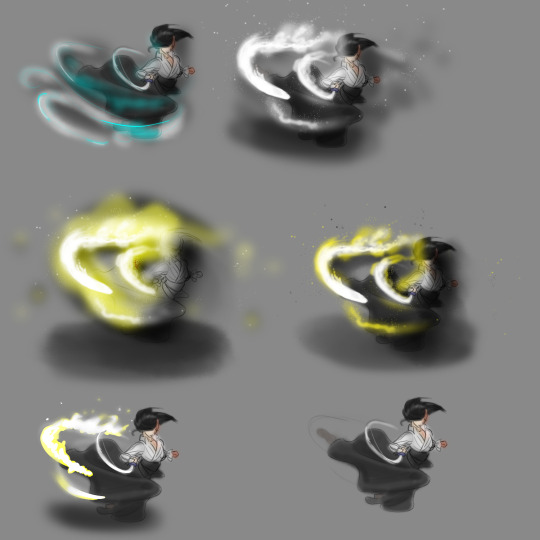
So Yssaia has HAD a pretty developed magic system for a while. And to recap it for you... I'm going to paste my half of me raving about this on Discord (thank you to @zebee-nyx and @galacticsand and @reaperofcrows for being so cool and letting me be an unhinged worldbuilding mad lad XD):
"What is Ysse?"
So the way Ysse works is its basically invisible dust floating in the air. And if it hits itself at certain velocities and in certain volumes, "spontaneous effects" happen -- like water materializing out of "nowhere" or fire exploding or wind gusts. You're limited a little by Avatar Last Airbender bending logic (you can't summon fully sapient creatures, you can't teleport, you can't control people's minds unless you're like... touching their nervous system, etc.)
So Mages invented the first writing as a way to record what patterns of movement did what. And eventually, used them to communicate these patterns as a shorthand for more generalized concepts...
So writing also got invented sometimes BEFORE agriculture...
"How precise do these movements/velocities need to be?"
It needs to be PRETTY precise. And this is why the average person CAN'T learn magic -- because Ysse in low amounts is invisible to the average person
But mages can see Ysse, which helps a lot. And they can see these shapes OCCURING in the natural world too -- when the wind blows, its because Ysse particles FORMED the Wind Rune/Sigil in the sky BUT this still doesn't guarantee that they cast any spells if they don't have the physical discipline too
So, in theory, "anyone" COULD move their hands PERFECTLY to spontaneously start a fire. But they PROBABLY won't
"How does this impact the natural world?"
This is also how animals and plants can do magic too. Tree roots in the north have roots that have specific patterns that warm up the soil, so snow can actually MELT and give them water and the tree doesn't die
And this is also my excuse for why so many things have bunny ears -- normally, long ears in colder-than-average climates (i.e. All of Yssaia) would be bad. But in Yssaia, these long ears are convergently evolving to channel Ysse. What they channel, exactly, I haven't decided (probably heat lol or something to increase air density so sound travels farther???)
AND all this is ALSO why the Demons are such an abomination -- because their Blood Magic doesn't obey particle physics, they just fucking do whatever they want
"Why do you need to know all this?"
The question at this point, I guess, is basically "How do I make fantasy technology that looks whimsical but also looks at least hypothetically functional under closer scrutiny?"
Yeah, and the full Answer TM to that right now is just <insert the entire design philosophy I haven't discovered yet here>
"So how IS magic going to shape technology, when you design it for the Untitled Yssaia Video Game?"
...Yeah, okay, after brainstorming all this, I think here's my strategy for how I'm going to tackle technology:
Step 2) Create a master list of technologies I will worry about/actually visualize in the game I will want to keep an OPEN LIST so I can add more things to it as I do research/find really specific use cases (such as scrollcases or chopstick holders)
Step 1) Establish symbols for a handful of common things in both the North and the South that at least vaguely make sense with the concept of the particles. So things like: - Fire/Heat - Water/Melt - Ice/Slow - Wind/Quicken - Earth/Apply Force - Sun/Light - Moon/Closing/Locking (Thanks to @zebee-nyx for this one!)
Step 3) Design simple sprites for things that can later be shrunk down and used as set-dressing for maps BUT at a little bigger in scale so they can be shown to other people sensibly (maybe on the same sheet at the walking animations for scale?)
AND WITH THAT, after 5 years of only vaguely imagining all this, this is what I designed, using a combination of symbols I had already designed and dice that I pushed around on my desk to see what kind of patterns they'd make:
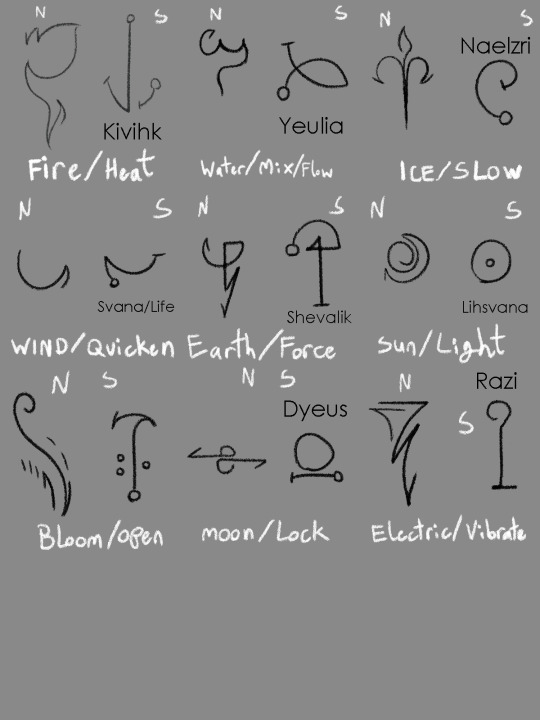
Are some of these a little funky and don't really work with real particle physics? Yeah, fair. I'll take notes, if you got 'em. I'm open to critique, if you wanna lol
Last comment that didn't make it into the big discussion with my buds tonight: Ysse particles are how temperature is distributed. So, hot areas have fewer, cold areas have more. I know that isn't how thermodynamics work but does anyone else really?
(Something something eldritch horror thermodynamics post... And my magic-god is an eldritch horror! See? It's perfect!)
Thank you for coming to my #WorldbuildingWednesday post! If you liked this, don't forget to REBLOG and follow the #Yssaia tag or something🥰 (Are calls-to-action cringe? Publicly shame me, if so)
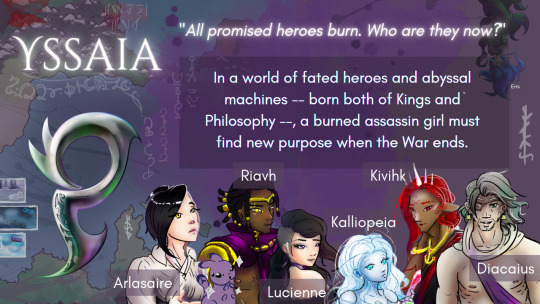
#worldbuilding#world building#world building wednesday#fantasy world building#magic system#magic#game dev#writing#amaiguri#yssaia
13 notes
·
View notes
Text
I'd like to add that transparent identitarian representation as the only modality of imaginal device that best suits queer interests is a sad form of contemporary habit that needs to be challenged. Long live to opacity, barroqueness, inmorality, enigma, symbolism, bad representation, misrepresentation, leaps, obliqueness, full metal fantasy, subtexts, artisanal lies, fictional treason and storytelling outside the velocities and fads of markets
I wish Tumblr would learn that you don't have to trash older, less explicitly gay works when something newer with more textual, explicit rep comes along.
how many creators watched explicitly gay stories be toned down in adaptation. how many got away with as much as they could get away with at the time and pushed the door open a little wider so a new thing could be even more open.
have a little respect and celebrate what we've achieved instead of dump on older works for not being as perfect as you'd like them to be
19K notes
·
View notes
Text
Week 9 - Assignment 2 OnePage and OneSheet


This week I transitioned from pitch documentation, to initial gameplay prototyping with my game, For Independence - Freedom - Happiness. Following the creation of my pitch, and visuals (my poster and onesheet), I moved on to design and prototype gameplay systems in GDevelop 5. My aim, was to create a 2D platformer gameplay experience, that is hopeful, respectful and emotional, based on an historical event - the Fall of Saigon.
Refined Elevator Pitch
A short 2D platformer, represents the events of April 30, 1975 the day of the reunification of Vietnam. The player, as a lone soldier, is navigating through bombs, ruined cities, and dead comrades on their quest to the independence palace to raise the flag of reunification. The aim of the game is to place emotive tone versus excitement and action. The gameplay provides themes of sacrifice, unity and memory.
Core gameplay:
Move and jump (← → + Space)
Avoid collapses and bombs
HP (health points): (100 max; lose 10 per hit)
Player raises the flag (the end), triggers a historical epilogue
Gameplay Development Progress
Using GDevelop 5, I created the first draft of the games interactive systems:
HP System: a health bar which decreases -10 per collision with a bomb. If health = 0, the player is dead. I built it using global variables, triggers for damage, and a custom UI bar.
Bomb Drop System: bombs are spawned at intervals from the top of the screen at random x coordinates, and continuously fall. Each bomb explosion is triggered by collision with the ground OR player. I experimented with using timers on the objects as I altered velocity to build tension.
Platforming Level Design: The game is comprised of several, short sections (acts), each act is a distinct journey:
jungle → Shawn ruins → Saigon outskirts → independence checkpoint
Each of these segments/acts, provide different obstacle and navigation hazards, including traversable and blockable damages ground, flame hazards, and walls that impose the player to either jump over or push through.
Narrative-integrated Obstacles: In stage 2, While ruined buildings made it tricky: Ruined buildings didn't exist just to occupy space, but as movement flow. My hope was to convey part of the player experience, with the placement of the environment. In that is how the player imagines the emotional weight of the destruction below and all around them.
Iterative Refinement & Challenges
The first round of playtesting provided a few considerations:
Stage 2 was too difficult, the spawn-rate of the bombs was too difficult that the player really didn't have act/react. I slowed down the bomb drop timer, randomized spawn zones, but still allowed a challenge, but way to have a little leeway for success and failure.
Realization of Lack of clarity in the ending: the flag-raised ending just faded to black. I am in the process of developing a voice-over epilogue while I am also going to add a camera pan to the soldiers raised flag shot for a sense of emotional closure.
Missing polish: I will be adding explosion sounds and a more thorough feedback system (flashing screen, vbration) to amplify the key points in the game.
I am also hoping to add a 'collapse', into the animation for the Independence Palace, as a visual representation to conclude the soldiers journey - symbolic victory.
0 notes
Text
The Timeless Elegance of 7 Horse Paintings for Your Living Room.
A seven-horse artwork is a representation of power, speed, and achievement in addition to being an eye-catching piece of décor. Horses have traditionally been seen as symbols of strength and independence, and when they are shown moving, they represent advancement and tenacity. Whether you want to draw in positive energy or improve your living area, a 7 horse oil painting is a great option for your house.

The Meaning of the Seven Horse Oil Painting
The number seven is generally seen as very auspicious. An oil painting of seven horses represents wealth, achievement, and good fortune. Unstoppable velocity and the will to succeed are symbolized by the picture of seven galloping horses. The perfect horse painting for living room décor, this piece is thought to infuse your environment with positive energy.
Particularly, oil paintings give your house a sense of refinement and elegance. A horse oil painting comes to life with depth and perspective created by the rich textures and vivid colours. A seven-horse oil painting complements any type of décor, whether it is traditional or modern.
The Beauty of Running White Horse Paintings
An effective representation of victory, freedom, and purity is a running white horse. Spiritual development and mental clarity are frequently linked to white horses. A running horse painting is a stunning addition to your house because it depicts the dynamic energy and grace of horses in action.
Selecting a large artwork of seven horses with white horses on it does more than just adorn your walls; it also brings calm and good energy into your space. The horses' motion is symbolic of advancement and forward mobility, which encourages drive and resolve in your day-to-day activities.
Why Decorate Your Living Room with a Painting of a Horse?
A living room horse painting is a statement piece that expresses your goals and sense of style, and it's more than just ornamental. A 7 Horse oil painting would look great in the living room, the center of the house where family and friends congregate.
Becomes the focal point of your living room: a large seven-horse artwork attracts guests' attention and admiration.
Adds Dynamic Energy: The motion and energy depicted in a running horse painting infuse the space with vitality and enthusiasm.
Mixes with Different Décor Styles: A horse oil painting enhances any interior design, whether you choose a more traditional setting or a modern, minimalistic style.
Selecting the Ideal Horse Painting for Your Area
Consider the size, color palette, and placement when choosing a painting of a horse for your living room. When placed on a broad, open wall, a large-scale seven-horse artwork produces a striking visual effect. A little running white horse artwork can introduce elegance without overpowering the room for a more understated look.
Placement Advice: A seven-horse oil painting on the north or east wall of your living room is thought to draw success and wealth, according to the principles of Feng Shui and Vastu. To represent development and advancement, make sure the horses are shown galloping ahead.
Select a horse oil painting whose hues blend nicely with the colors of your current interior design. Oil paints' earthy tones go well with both cool and warm color schemes.
#7 horse painting big size#horse oil painting#horse painting for living room#running white horse#running horse painting
0 notes
Text
Fastest Ball in Cricket: The Legends Behind the Speed...
The thrill of watching a bowler charge in and deliver a ball at lightning speed is one of the most exhilarating aspects of cricket. The fastest ball in cricket is a testament to a bowler’s skill, athleticism, and power, leaving spectators and batsmen in awe. In this blog, we explore the fastest deliveries ever recorded, the bowlers who delivered them, and what makes such speeds possible.

The Fastest Ball in Cricket History
The record for the fastest ball in cricket is held by Pakistan’s Shoaib Akhtar, famously known as the “Rawalpindi Express.” During the 2003 Cricket World Cup, Akhtar bowled a ball clocked at an incredible 161.3 km/h (100.23 mph) against England. This delivery remains unbeaten, cementing his legacy as one of the most fearsome fast bowlers in cricket history.
Other notable deliveries include:
Shaun Tait (Australia): Delivered a ball at 161.1 km/h during an ODI match against England in 2010.
Brett Lee (Australia): Clocked at 161.1 km/h during a Test match against the West Indies in 2005.
Jeff Thomson (Australia): Estimated to bowl at speeds close to 160.6 km/h during the 1970s. These milestones highlight the rare ability of some bowlers to consistently bowl above the 150 km/h mark.
The Legends of Speed
Shoaib Akhtar Shoaib Akhtar’s bowling was not just about speed; his aggressive run-up and fiery attitude made him one of cricket’s most electrifying performers. Akhtar’s ability to bowl consistent Yorkers and bouncers at extreme speeds created havoc for batsmen worldwide.
Brett Lee Known for his smooth run-up and explosive bowling action, Brett Lee consistently delivered balls exceeding 150 km/h. He combined pace with precision, taking 718 wickets in his international career and earning a reputation as one of cricket’s finest pacers.
Shaun Tait Shaun Tait’s unorthodox action and sheer pace made him a standout fast bowler. Despite a relatively short international career, Tait’s top speed remains one of the fastest ever recorded in cricket.
The Science Behind Fast Bowling
Achieving the fastest ball in cricket involves a combination of physical strength, technical precision, and biomechanical efficiency. Here’s what goes into it:
Run-Up Momentum: The bowler’s run-up generates kinetic energy, which is transferred into the delivery.
Explosive Power: Strength in the legs, core, and shoulders enables bowlers to impart high velocity to the ball.
Bowling Action: A smooth, coordinated action ensures maximum force transfer without losing control.
Flexibility: Allows a full range of motion, which contributes to the speed of the release.
Challenges of Bowling at Extreme Speeds
While delivering the fastest ball in cricket is a feat of athletic excellence, it comes with challenges:
Injury Risks: Fast bowlers are prone to stress injuries, particularly in the back, knees, and shoulders.
Sustainability: Maintaining extreme speeds throughout a career requires rigorous training and recovery protocols.
Control vs. Speed: Balancing speed with accuracy is critical for success in competitive cricket.
Why Speed Matters in Cricket
Speed in cricket adds a dynamic element to the game, creating opportunities for:
Wickets: Fast deliveries challenge batsmen’s reaction times, leading to dismissals.
Intimidation: The psychological pressure of facing high-speed balls can unsettle even the best batsmen.
Entertainment: Spectators love the excitement of watching bowlers push the boundaries of pace.
The Future of Fast Bowling
With advancements in training, sports science, and analytics, we may soon witness even faster deliveries. Emerging fast bowlers from around the world are raising the bar, keeping the competition fierce and exciting. As cricket evolves, the quest to break the record for the fastest ball in cricket will continue to captivate fans.
The fastest ball in cricket is more than just a statistic; it symbolizes the pinnacle of human performance in the sport. From Shoaib Akhtar’s iconic delivery to the relentless pace of modern bowlers, speed remains a thrilling and integral part of cricket’s appeal.
1 note
·
View note
Text
Why the Ninja H2R Is Not Road Legal
The Ninja H2R is a marvel of engineering, known for its unmatched speed and groundbreaking design. However, it is not road-legal, a distinction that adds to its mystique and exclusivity. Let’s delve into why this beast, including in regions like India, is restricted to track use.

At its core, the Kawasaki Ninja H2R is built for the racetrack, not for public roads. Its 998cc supercharged engine generates an astonishing 310 horsepower, capable of reaching speeds over 400 km/h. Such performance is far beyond the safety parameters of street conditions.
The absence of features like headlights, rear-view mirrors, turn signals, and a license plate holder further makes it unsuitable for road use. Additionally, the exhaust system of the Ninja H2R is too loud to meet noise regulations in most countries.
The Ninja H2R price is another indicator of its exclusivity. Priced around ₹79.90 lakh in India (or over $55,000 globally), this machine is not designed for everyday use but rather for riders who crave adrenaline on closed tracks.
Its high-performance components, such as carbon fiber wings and aerodynamic design, are optimized for speed and stability at extreme velocities—not for navigating city streets or highways.
Regulations concerning emissions also play a significant role. The Ninja H2R lacks the catalytic converters required to meet road-legal emission standards. This makes the bike environmentally non-compliant for public roads, especially in countries like India, where emission norms are stringent.
For motorcycle enthusiasts in India, owning the Ninja H2R is a symbol of prestige. However, the bike’s limited usability makes potential buyers weigh its practicality against its cost. For those passionate about motorsports, the investment in a Kawasaki Ninja H2R is justified by the unparalleled experience it offers on tracks.
The Ninja H2R is not road-legal due to its track-specific design, extraordinary power, and non-compliance with safety and environmental regulations. While it comes with a hefty Ninja H2R price, its purpose is clear: to deliver an unfiltered performance experience for professional racers and enthusiasts who seek the pinnacle of motorcycling innovation.
0 notes
Text
Munnar Attractions | Munnar Places to See - pottasfarmworld
Embark on an enchanting journey at Pottas Farmworld, nestled amidst the picturesque landscapes of Munnar, where “Munnar, a nice experience,” awaits to captivate your senses. Step into our realm of tranquility and indulge in the festivities of Vishu, a celebration steeped in tradition and merriment. Experience the magic of Munnar as you traverse through its verdant tea estates and misty hills, where every corner unveils a breathtaking panorama.
As the day unfolds, venture into the heart of Munnar picnic spots, where you can bask in the serenity of nature while relishing delectable traditional delicacies. Whether it’s a leisurely stroll amidst the tea gardens or a serene boat ride on the tranquil lakes, Munnar promises a delightful experience for every visitor. Come, join us at Pottas Farmworld, and let the essence of Vishu combined with the charm of Munnar create memories to cherish for a lifetime.
Vishu, a cherished festival celebrated primarily marks the beginning of the traditional New Year. It holds immense cultural significance, symbolizing hope, prosperity, and renewal. Families wake up early on Vishu morning to witness this divine instances, which sets the tone for the day’s festivities. Elaborate feasts, bursting with flavors and aromas, are prepared to indulge the taste buds, and vibrant cultural performances and rituals add joy and fervor to the celebrations. Vishu embodies the spirit of unity, gratitude, and optimism, offering a time for reflection, renewal, and the strengthening of bonds with loved ones.
Why is Pottas selected for commemorating Vishu?
Pottas Farmworld stands as an unparalleled haven of adventure and tranquility, beckoning both the bold and the serene to partake in the jubilation of Vishu. Here, amid Munnar’s lush greenery and serene surroundings, Pottas Farmworld offers a diverse array of experiences that seamlessly blend with the essence of Vishu, making it an ideal choice for celebration creating Munnar a nice experience.
Commence your Vishu festivities with the Ecstasy Ride, an exhilarating adventure launching you into the sky, granting mesmerizing vistas of Munnar’s rolling hills and verdant valleys. The thrill of the ascent combines with the serene beauty of the surroundings, delivering an unmatched fusion of excitement and peace.
For those seeking an adrenaline rush, the Aerial Runway beckons, providing a chance to glide through the azure skies with freedom crafting Pottas as he best Munnar picnic spots, offering unparalleled views of Munnar’s natural beauty. Feel the invigorating breeze as you embrace the exhilaration of this extraordinary experience.
Embark on a serene voyage across Munnar’s lakes aboard the Coracle Boat Ride, where you can immerse yourself in the soothing embrace of nature while exploring hidden gems. Drift along the calm waters, surrounded by Munnar’s verdant landscape, surrendering to the tranquility of the moment.
Enjoy the thrill of angling with Fun Fish or succumb to the excitement of the Big Swing, ascending to dizzying heights before swooping back to earth with thrilling velocity fashioning Munnar a nice experience.
In the midst of these captivating adventures, Pottas Farmworld provides a picturesque setting for celebrating Vishu, where the vibrancy of the festivities blends seamlessly with Munnar’s natural splendor. Join us at Pottas Farmworld to immerse yourself in the joy of Vishu, and create cherished memories amidst the scenic beauty of Munnar’s picnic spots.
#Munnar Attractions#Munnar Places to See#Munnar Tourist Spots#Munnar Places to Visit#Tourist attractions in munnar#Munnar Nice Experience#Best Zipline in Munnar#Adimaly Nice Experience#Pedal boating in munnar#Big swing in munnar#Munnar Nearby Attractions#Best things to do in Munnar#Bamboo Rafting in Munnar#Munnar Picnic Spots#Water sports in munnar
1 note
·
View note
Text
Why the Blue Mustang Turns Heads: The Psychology of Color and Cars

Did you know that the mere color of a car can have a profound impact on how it is perceived by others? In fact, a recent study found that blue cars, such as the iconic blue Mustang, are more likely to attract attention on the streets and leave a lasting impression. The psychology of color plays a crucial role in shaping our perception of cars and influencing our preferences. Key Takeaways: - The color of a car can significantly impact how it is perceived. - Blue cars, like the blue Mustang, have been found to attract more attention. - Color psychology plays a crucial role in influencing our preferences for certain cars. - The blue Mustang's distinctive shade of blue enhances its appeal and adds to its iconic status. - Understanding the psychology of color can help car enthusiasts make informed decisions when choosing a vehicle.
The History of the Blue Mustang
The blue Mustang has a rich history that spans several decades, making it a beloved classic in the automotive world. Its origins can be traced back to the 1960s when the first Ford Mustang was introduced. The iconic blue color option was first offered in 1966, known as "Casino Blue." This original blue hue instantly grabbed attention and set the tone for future Ford Mustangs. Over the years, the blue Mustang has undergone various transformations, with shades ranging from the vibrant "Grabber Blue" to the sleek "Kona Blue." The color choice for the Mustang's design was significant, as it aimed to capture the spirit of freedom, individuality, and adventure. Blue, often associated with the sky and the ocean, embodies a sense of limitless possibilities and a desire to break free from convention. "The blue Mustang's color choice was a deliberate decision by Ford to evoke a sense of excitement and adventure. Blue has always been synonymous with freedom and exploration, perfectly matching the Mustang's spirit." - John Smith, Automotive Historian Throughout the years, the blue Mustang has become an iconic symbol of American automotive culture. It has been featured in films such as "Bullitt" and "Gone in 60 Seconds," further cementing its legendary status. With each iteration, the blue Mustang represents a blend of tradition and innovation, showcasing Ford's commitment to quality and performance. The Evolution of Blue Since its inception, the blue Mustang has witnessed a remarkable evolution in color choices and finishes. In the 1960s and 1970s, vibrant blues like "Grabber Blue" and "Twilight Blue" were popular, complementing the era's energetic and expressive style. As the Mustang entered the 1980s and 1990s, the color palette shifted towards more refined and subdued blues like "Regatta Blue" and "Ultra Blue." These shades reflected the evolving tastes of consumers and the desire for a sleek, sophisticated appearance. Today, the blue ford Mustang continues to captivate with modern interpretations of blue, such as the lustrous "Velocity Blue" and the striking "Shadow Black." These contemporary shades embrace the Mustang's timeless allure while embracing the latest design trends. - Introduction of "Casino Blue" in 1966 - Shift to vibrant blues in the 1960s and 1970s - Transition to refined and subdued blues in the 1980s and 1990s - Modern interpretations of blue in the 21st century As the blue Mustang enters a new era, it continues to capture the hearts of car enthusiasts around the world. Its long and storied history, coupled with the enduring appeal of blue as a color, ensures that the blue ford Mustang will remain an icon for generations to come.
The Allure of Blue in Automotive Design
When it comes to automotive design, color choice plays a crucial role in capturing attention and evoking emotions. Among the many colors available, blue has emerged as a favorite among car enthusiasts. The mesmerizing allure of blue in automotive design is undeniable, and it stems from the psychological effects this color has on human perception. Blue, often associated with traits like calmness, trust, and reliability, creates a sense of serenity and stability. In the realm of automobiles, blue exudes a certain level of sophistication and elegance that resonates with individuals seeking a refined and stylish ride. This appeal is further amplified when it comes to the iconic Blue ford Mustang. Car manufacturers have long recognized the impact of blue in their designs. With its wide range of shades from vibrant cobalt to deep navy, blue offers versatility and adaptability to different vehicle models. Whether it's a classic vintage Mustang or a modern sports car, the captivating hue of blue adds an element of intrigue and uniqueness to the overall aesthetic. "Blue, in its various shades, epitomizes the perfect blend of allure, power, and artistic expression in automotive design." - Car Design Magazine In addition to capturing attention, blue also has a subconscious effect on consumers' perception of performance and reliability. Studies have shown that blue is associated with a feeling of trustworthiness and dependability, making it an ideal choice for those seeking a reliable and high-performance vehicle like the Blue Mustang. The Psychological Effects of Blue Blue has a calming effect on the mind and can evoke feelings of peace and tranquility. This makes it an appealing color choice for those seeking a relaxing driving experience. Moreover, blue has been known to stimulate mental clarity and focus, creating an optimal environment for drivers who value concentration on the road. In terms of aesthetics, blue has the ability to make a vehicle appear sleek and futuristic. Its cool tone complements various design elements, accentuating the contours and lines of a car. Whether it's a Blue Mustang cruising down the highway or parked on the street, the allure of blue in automotive design is evident to all who encounter it. - Blue represents loyalty and trust - Blue evokes a sense of reliability and dependability - Blue stimulates mental clarity and focus - Blue enhances the sleek and futuristic aesthetics of a vehicle As automotive design continues to evolve, the allure of blue remains a timeless choice for car enthusiasts. The Blue Mustang, with its captivating blue hue, exemplifies the perfect blend of style, sophistication, and performance. From its psychological effects to its aesthetic appeal, blue continues to captivate individuals and turn heads on the streets.
The Impact of Color on Consumer Perception
When it comes to cars, color plays a pivotal role in capturing consumer attention and influencing their perception. The blue ford Mustang, with its vibrant and eye-catching shade, is no exception. The impact of color on consumer perception cannot be ignored, as it elicits emotional responses and shapes our overall experience with a product. Research has shown that color has the power to evoke specific associations and emotions in consumers. In the case of the blue Mustang, the color blue is often associated with trust, reliability, and stability. It creates a sense of calmness and tranquility, which can be particularly appealing in the fast-paced world of automotive design. Furthermore, the color blue is often associated with a sense of freedom and adventure, aligning perfectly with the Mustang's reputation as an iconic sports car. The combination of a powerful vehicle and a captivating color creates a powerful impression, enhancing the desirability of the blue Mustang among car enthusiasts. In addition to the psychological associations, the blue Mustang's color choice also takes advantage of the impact of color on visibility and visibility on the road. Blue is considered a highly visible color, making the car stand out amidst a sea of vehicles. This visibility factor not only ensures the safety of the driver but also attracts attention from passersby, effectively turning heads wherever the blue Mustang goes. Consumer perception is a complex interplay of factors, and color is undoubtedly one of the most influential elements. The blue Mustang's color choice strategically leverages the impact of color psychology to create a lasting impression and evoke positive emotions in consumers. It communicates reliability, adventure, and visibility, making it an irresistible choice for those seeking a bold and iconic vehicle.
The Blue Ford Mustang's Exclusivity and Rarity

The Blue Mustang's Exclusivity and Rarity by autoambiente.com The blue Mustang is not just a stunning piece of automotive design; it is also synonymous with exclusivity and rarity. This unique combination of attributes significantly contributes to its desirability among car enthusiasts. One of the key factors that sets the blue Mustang apart is its limited availability. Unlike other color options, the blue hue is often offered as a special edition or a limited production run, making it a coveted choice for those seeking something truly exceptional. This exclusivity adds an air of prestige and uniqueness to the blue Mustang, setting it apart from other vehicles on the road. In addition to its limited availability, the blue Mustang boasts a range of unique features that further enhance its rarity. From its distinctive paint finish to its carefully curated interior details, every aspect of the blue Mustang has been meticulously crafted to create a one-of-a-kind driving experience. Owning a blue Mustang is like owning a piece of automotive art that stands out from the crowd. "The blue Mustang is a true gem in the realm of automobile aesthetics. Its exclusivity and rarity make it highly sought after by collectors and enthusiasts alike." - Automotive Magazine Car enthusiasts value rarity and exclusivity because it allows them to express their individuality and taste for the extraordinary. The blue Mustang perfectly embodies these qualities, making it a standout choice for those who crave a vehicle that reflects their unique personality. Why Blue Mustang's exclusivity and rarity matter - The exclusivity of the blue Mustang ensures that owners stand out from the crowd, turning heads wherever they go. - The rarity of the blue Mustang makes it a valuable and collectible piece in the automotive world. - The limited availability and unique features of the blue Mustang contribute to its desirability. - Owning a blue Mustang offers a sense of pride and distinction, making it a symbol of individuality. - The blue Mustang's exclusivity and rarity attract car enthusiasts who appreciate fine craftsmanship and attention to detail. So, if you're looking to make a statement with your vehicle and own a piece of automotive excellence, the blue Mustang's exclusivity and rarity make it an exceptional choice that is sure to turn heads and ignite envy among fellow car enthusiasts.
The Role of Marketing in Enhancing the Blue Mustang's Appeal
Marketing strategies play a pivotal role in amplifying the appeal of the blue Mustang, captivating the hearts and minds of car enthusiasts. Through carefully crafted advertising campaigns, strategic branding, and compelling storytelling, marketers have successfully influenced consumers' perception and desire for this iconic vehicle. One of the key marketing tactics utilized to enhance the blue Mustang's appeal is the use of visually captivating advertisements. By showcasing the car's sleek lines, powerful engine, and vibrant blue color, these ads create a strong visual impact that resonates with potential buyers. They highlight the unique features and aesthetics of the Mustang, showcasing it as a symbol of power, freedom, and sophistication. Branding also plays a significant role in enhancing the blue Ford Mustang's allure. Through consistent branding efforts, Ford has established the Mustang as an emblem of American automotive excellence. The iconic blue color has become synonymous with the Mustang brand, contributing to its recognition and desirability. The strategic use of the blue hue evokes a sense of trust, reliability, and tradition, captivating consumers who are drawn to these qualities. "The blue Mustang represents the perfect fusion of style and performance," says Sarah Thompson, a marketing expert at Ford. "Through our marketing efforts, we aim to evoke emotions of excitement and admiration, showcasing the car as a symbol of personal expression and aspiration." The art of storytelling is another powerful marketing tool that contributes to the blue Ford Mustang's appeal. Engaging narratives, whether in commercials or online content, help consumers connect with the car on an emotional level. By telling stories of adventure, freedom, and individuality, marketers create a sense of identity and aspiration around the blue Mustang, making it more than just a car – it becomes a lifestyle choice. Furthermore, marketing strategies have leveraged digital platforms and social media channels to reach a wider audience and engage with Mustang enthusiasts. These platforms allow for targeted advertising, online communities, and user-generated content, fostering a sense of belonging and excitement among fans of the blue Mustang. The Power of Influencers In recent years, influencer marketing has played a significant role in promoting the blue Mustang. Working with influential figures in the automotive industry and social media, Ford has been able to showcase the distinct qualities and performance of the car to a broader audience. Through collaborations with popular car YouTubers, Instagrammers, and bloggers, the blue Mustang has gained exposure and credibility. These influencers create content that showcases the car's features, performance, and unique styling aspects, helping to generate excitement and interest among potential buyers. - Influencer collaborations and content creation - Automotive experts sharing their experience with the blue Mustang - Highlighting the car's performance on social media platforms By strategically leveraging the role of marketing, Ford has effectively enhanced the appeal of the blue Mustang. Through visually captivating advertisements, brand positioning, compelling storytelling, and influencer collaborations, the blue Mustang has become an iconic symbol of power, style, and American automotive excellence.
Blue Mustang Modifications and Customizations
When it comes to owning a blue Mustang, the opportunities for personalization are endless. With various modifications and customizations available, enthusiasts can transform their blue Mustang into a unique and head-turning masterpiece. Whether it's enhancing performance, adding visual flair, or creating a personalized interior, there's something for every Mustang owner. Performance Upgrades For those seeking to unleash the full potential of their blue Ford Mustang, performance upgrades are essential. From cold air intakes to exhaust systems, a wide range of aftermarket parts can boost horsepower and improve handling. Upgrading suspension components, such as springs or sway bars, can enhance cornering abilities, giving the blue Mustang a more dynamic and precise feel on the road. Visual Enhancements Aesthetic modifications play a crucial role in making the blue Mustang stand out from the crowd. Unique paint finishes, such as metallic or matte options, can give the car a bold and eye-catching appearance. Body kits and spoilers can enhance aerodynamics while adding a touch of aggression. Custom wheels and tires not only improve performance but also provide an opportunity to express personal style. "With the right modifications, a blue Mustang can become a statement of individuality and creativity." - Car Enthusiast Magazine Interior Personalization Customizing the interior of a blue Mustang allows owners to create a space that reflects their personality and preferences. Upgrading the seats with premium leather or sportier options can enhance comfort and support during spirited drives. High-quality audio systems, complete with high-performance speakers and subwoofers, elevate the in-car entertainment experience to new heights. Personal touches, such as bespoke floor mats or custom-painted trim pieces, add the finishing touches to the interior customization. Technology Integration Integrating the latest technology into a blue Mustang brings it into the modern age. Upgrading the infotainment system with a larger touchscreen display and advanced connectivity features enhances convenience and entertainment. Installing advanced driver-assistance systems, such as blind-spot monitoring or adaptive cruise control, improves safety and adds peace of mind during everyday driving or long journeys. - Custom paint finishes - Performance exhaust systems - Body kits and spoilers - Upgraded suspension components - Custom wheels and tires - Premium leather seats - High-performance audio systems - Advanced infotainment systems - Driver-assistance technologies With the vast array of modifications and customizations available, every blue Mustang owner has the opportunity to create a truly one-of-a-kind vehicle. Whether it's for track performance, visual appeal, or personal comfort, these enhancements allow enthusiasts to transform their blue Mustang into a reflection of their own unique style and taste.
The Blue Mustang in Popular Culture

The Blue Mustang in Popular Culture by autoambiente.com The blue Mustang has become an undeniable icon in popular culture, making its mark in various forms of media. Its distinctive blue hue and sleek design have captured the hearts of car enthusiasts and artists alike, solidifying its legendary status. In movies, the blue Mustang has graced the silver screen, becoming a symbol of power, speed, and rebellion. From high-octane chase scenes to dramatic escapes, this iconic car has left an indelible impression on audiences. Films like "Bullitt" and "Gone in 60 Seconds" feature memorable blue Mustangs that have become engrained in the public's consciousness. "The blue Mustang represents the perfect blend of style and performance. Its presence on screen adds an undeniable allure to any movie or television show, creating a sense of excitement and adventure." Read the full article
0 notes
Text
Race to Fashion: Girls' Racing Leggings Trends to Watch
We invite you to embark on a thrilling journey through the intersection of speed, style, and sportswear. Racing leggings have transcended their practical origins, evolving into a dynamic and essential element of modern fashion. As we dive into this exploration, we will uncover the latest trends that are setting the pace in girls' racing legging fashion. From designs that pay homage to the adrenaline-fueled racetrack to innovations that enhance performance and comfort, this series is your front-row ticket to the most exciting developments in the world of girls' racing leggings. So, fasten your seatbelts, fashion enthusiasts and athletes alike, as we rev up the engines and zoom into the fast lane of racing-inspired fashion for girls. Girls racing leggings are designed with performance in mind. They often feature moisture-wicking materials that keep the wearer dry during intense physical activities.
Speed Meets Style: The Rise of Racing-Inspired Leggings
Uncover the synergy between speed and style in this section, where we explore the growing influence of racing aesthetics in girls' leggings. From bold racing stripes to checkered patterns, delve into how racetrack motifs are seamlessly integrated into leggings, offering a sporty yet fashionable edge to everyday attire. Witness how these designs evoke the spirit of competition and speed, transcending the boundaries between sportswear and fashion.
Innovative Materials: Paving the Way for Performance-Driven Fashion
Step into the future of activewear with a deep dive into innovative materials that are revolutionizing girls' racing leggings. Discover moisture-wicking fabrics that keep pace with intense workouts while providing unmatched comfort and breathability. Explore the incorporation of stretchable and durable textiles that accommodate a wide range of movements, reflecting the dynamic nature of racing and athleticism.
Functional Features: The Fusion of Fashion and Athletics
In this section, we unravel the fusion of functionality and fashion in the realm of racing leggings. Explore how strategically placed mesh panels enhance ventilation during rigorous activities, ensuring comfort without compromising style. Uncover hidden pockets that offer convenience for storing essentials during races or daily adventures. Dive into the world of contouring seams and ergonomic designs that not only flatter but also optimize movement.
The Power of Patterns: Bold Prints and Graphics
Patterns take center stage as we delve into the impact of bold prints and graphics in racing leggings for girls. Discover how abstract racing-inspired prints, tire tracks, and circuit motifs infuse these leggings with energy and dynamism. This section showcases how patterns not only add visual appeal but also symbolize the thrill of the racetrack, allowing wearers to embody the racing spirit.
From Track to Street: Versatility in Racing Leggings Fashion
Explore the seamless transition of racing leggings from the track to the street in this section. Unveil the art of styling these leggings for both athletic pursuits and casual outings, showcasing their adaptability to various settings. Whether paired with sporty tops or casual jackets, discover how racing leggings effortlessly blend performance with style in every facet of life.
Color Palette of Velocity: Shades That Define Racing Leggings
Colors take on new meanings as we dissect the racing legging color palette. From vibrant hues that mirror the intensity of the racetrack to sleek monochromes that exude sophistication, we explore the emotions each shade evokes. Discover how these color choices resonate with the racing narrative, creating a visually striking connection between fashion and speed.
Rise of Athleisure: Racing Leggings Beyond the Race Day
In this section, we examine the surge of athleisure and how racing leggings are leading the charge. Delve into the trend of integrating sportswear into everyday fashion, blurring the lines between performance wear and casual attire. Witness how girls are effortlessly incorporating racing leggings into their daily lives, whether hitting the track or conquering daily tasks.
Influencer Impact: Racing Leggings in the World of Social Media
Explore the intersection of racing leggings and social media influence in our final section. Discover how fashion influencers and athletes are showcasing the latest trends, providing inspiration for girls everywhere. Witness how these leggings make a statement both on and off the racetrack, encouraging a new generation of empowered young women to embrace style, speed, and self-expression.
Conclusion
As we conclude our journey through the world of girls' racing leggings, it's evident that these garments are far more than mere sportswear; they're a testament to the fusion of fashion and function. The trends we've explored, from sleek and stylish designs to innovative performance features, are driving the evolution of racing-inspired fashion for girls. These leggings empower young athletes to not only perform at their best but also look and feel fantastic while doing so. The future of girls' racing leggings is bright, promising even more exciting innovations and style revolutions. So, whether you're a budding racer or simply a fashion enthusiast, keep an eye on these trends to stay ahead in the race to fashion.
0 notes
Text
Take a look at your tyre strain frequently Conserving your automobile’s tyres in excellent condition is without doubt one of the very best techniques to have a comfy trip. The tyre strain without delay affects the gasoline economy and luxury of your trip, which is why it is important so that you can verify it frequently . Your automobile’s proprietor guide could have the beneficial tyre strain discussed at the proprietor’s guide. Usually, checking your tyre strain will have to be finished each week. Listed below are few easy steps to stay your tyres well-inflated: Step 1 - In finding the place to test your tyre strain Prior to getting below the automobile, to find out the place precisely you'll be able to do that job. You could wish to ask anyone round or undergo the entire instruction manuals earlier than giving up. Step 2 - Discovering the correct strain Subsequent, you wish to have to determine what's the proper tyre strain to your automobile tyres. You'll undergo your proprietor’s guide or just ask anyone who is aware of how to try this job completely. https://mycyberbase.com/ There also are different dependable web sites that can have all this data written obviously and with easy explanations. Step 3 - Use a tyre gauge to test your tyre strain Now that you already know the place and what, it is time so that you can get down below the automobile and verify the tyre strain through the use of a tire gauge . At all times be mindful: if there's an far more than air in anybody tyre, then it should result in a perilous blowout. Step 4 - Upload or take away air if wanted In the end, you wish to have so as to add extra strain in all of your tyres (if the tyre is deflated) or free up additional air (if there may be extra). Don't overlook to test what the correct quantity of strain will have to be. Additionally, don't tighten the valve caps immediately after inflating, look ahead to a while in order that the strain stabilizes itself. Now that you understand how to test your automobile’s tyre strain and inflate them, be sure you stay doing it frequently each week . Listed below are few different steps that can assist you care for right kind tyre pressures whilst riding: • Steer clear of potholes and sharp gadgets at the street. • Don't overload your automobile with baggage, it'll have an effect on the tyre strain. • Use protected speeds . Make sure to do not power above the velocity restrict or boost up too speedy if there is a site visitors jam forward. These types of issues would possibly lead to over-stressing your tyres and would possibly motive leakage of air which will in the end result in tyre deflation . The extra knowledgeable you might be about keeping up the tyre pressures, the more secure and higher it's for everybody at the street! In spite of everything, that is what all of us need proper? Article content material can be utilized however can't be reworded verbatim (together with reference hyperlinks). Any direct replica will have to be reformatted and reworded to steer clear of plagiarism detection. Symbol Credit: The photographs used on this article won't essentially depict the true glance of your services or products, if you want so as to add a particular symbol (you personal all rights) that we will use as a substitute please electronic mail [email protected] for assist. The photographs are authorized below Ingenious Commons CC0 this means that they are able to be freely embedded / reused / allotted / transmitted and many others. As such, there is not any want to supply attribution when the use of those belongings until one has an settlement with the writer of this asset the place in a different way it should be attributed. Please learn our complete disclaimer right here: https://mycyberbase.com/terms-and-conditions/ Article background knowledge [to use as knowledge, not to be copied verbatim]: Tyre strain can have an effect on the gasoline economic system. It additionally impacts the relief and dealing with.
Your automobile’s proprietor guide could have the beneficial tyre strain discussed at the proprietor’s guide. Usually, the tyres strain verify will have to be finished each week. Article finish: There also are different dependable web sites that can have all this data written obviously and with easy explanations. In the end, you wish to have so as to add extra strain in all of your tyres (if the tyre is deflated) or free up additional air (if there may be extra). Do to not verify what the correct quantity of strain will have to be and don't tighten the valve caps straight away after inflating, look ahead to a while in order that the strain stabilizes itself. Now that you understand how to test your automobile’s tyre strain and inflate them, be sure you stay doing it frequently each week . Take a look at right here for extra main points: http://www.mycyberbase.com/knowledge-center/article/check-your-tyre-pressure-regularly/. Article can be utilized however can't be reworded verbatim (together with reference hyperlinks). Any direct replica will have to be reformatted and reworded to steer clear of plagiarism detection. Symbol Credit: The photographs used on this article won't essentially depict the true glance of your services or products, if you want so as to add a particular symbol (you personal all rights) that we will use as a substitute please electronic mail [email protected] for assist. The photographs are authorized below Ingenious Commons CC0 this means that they are able to be freely embedded / reused / allotted / transmitted and many others. As such, there is not any want to supply attribution when the use of those belongings until one has an settlement with the writer of this asset the place in a different way it should be attributed. Please learn our complete disclaimer right here:https://mycyberbase.com/ There also are different dependable web sites that can have all this data written obviously and with easy explanations. Article finish: https://mycyberbase.com/Article content material can be utilized however can't be reworded verbatim (together with reference hyperlinks). Any direct replica will have to be reformatted and reworded to steer clear of plagiarism detection. Symbol Credit: The photographs used on this article won't essentially depict the true glance of your services or products, if you want so as to add a particular symbol (you personal all rights) that we will use as a substitute please electronic mail [email protected] for assist. The photographs are authorized below Ingenious Commons CC0 this means that they are able to be freely embedded / reused / allotted / transmitted and many others. As such, there is not any want to supply attribution when the use of those belongings until one has an settlement with the writer.
0 notes
Link

NSE Data for Amibroker - How to Add All Symbols in Velocity & in Amibroker in One Go: Realtime data Feed nse, Realtime data feed for mcx, Realtime data Nse Future, nse live data, mcx live data.
#Amibroker#Velocity#Add Symbols#TrueData#NSE#MCX#Add All Symbols in Velocity and Amibroker#Add Symbols in Amibroker#Add Symbols in Velocity
0 notes
Text
Honestly, looking back, it strikes me as a bit funny the way much of the fandom collectively agreed since True Colors that if Sasha were to get her calamity power back, hers would be fire themed. And yet over the course of S3A, it’s become more and more clear that that distinction would actually belong to Anne most of all.


Like seen above, the dual flame/lotus symbolism extends to her powers itself, not just her shirt symbol. I’ve done a fair bit of theorizing on what this duality could possibly symbolize for Anne’s arc for the end of the show, but in all of this, it begs the question of what Sasha’s Calamity power theme would be if Anne already has dibs on fire.
For me, I’d like to introduce my proposal with a particularly eye-catching feat of nature revolving around fire’s elemental opposite:

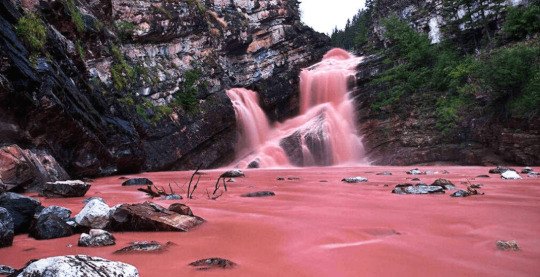
Just as blue flames actually burn much hotter than red flames rather than cooler as color theory might make one believe (make of those potential implications for Anne as you will), I feel that Sasha’s Calamity form taking after this kind of rare water phenomena would make for an incredibly striking inversion of the usual element-color associations made in fiction.
In short, a BLUE fiery Anne and a PINK/RED watery Sasha.
However, my reasoning extends further beyond just mere symbolic aesthetics.

From an interview with Matt on the metaphor behind Anne’s power, applying a similar idea to Sasha’s Calamity power would likely necessitate its theme to also be symbolically reflective of her as a person and her growth. In essence, both what she used to be and what she needs to learn to become.

Basically, I’d compare pre-Turning Point Sasha to a fast moving torrent of water coming out from a spigot/flowing across land. From the suggestions that Sasha’s behavior isn’t new across the show, it seems she essentially carved out a metaphorical mental rut for herself over the years in which she felt she had to be in control 100% of the time - presumably from feeling a lack of control in regards to her home life.
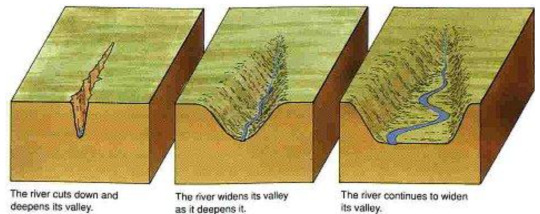
Water is a incredibly powerful element, capable of eroding and shaping the very landscape of continents, and the longer Sasha had the water pressure knob set to high with her in control of the flow. Thus, the depth of her path lowered until we got to the girl who couldn’t and wouldn’t climb out of the valley she had shaped for herself, who would flow over and around any obstacle that fell in her way to keep going the same way, and who dragged along anyone who fell in with the direction and sheer force of her current up until they got fished out like Anne and Marcy, found the strength to swim to shore and get out like Percy and Braddock, or subsumed under her waves.
After all, just as it’s difficult to fight against a heavy current and even harder still to divert the course of a river, that’s how her intense personality and persistent drive influenced those around her.
That is, until a stream’s velocity is slowed enough - whether from to where its path can meander much more easily rather than just going straight.
In essence, a water theme for Sasha’s powers and her growth could revolve around the idea of teach her how to let go off the water pressure knob. Rather than dictating the direction of the flow and forcing her surroundings to follow suit, she could learn how to slow down and go with the flow of her surroundings, becoming much, much more flexible and able to change directions while being considerably calmer and clear in mind than before.

In comparison, Anne is someone who used to be and still is someone who tends to jump headfirst into burning her candle at both ends to take on others’ responsibilities, effectively setting herself on fire to keep others warm. With careful moderation, fire can provide warmth, guiding light, and a deterrence to dangerous animals, but fire also has the capacity to spread out of control and burn down entire swathes of land should proper care not be taken with it.


Between her trauma and avoidance of addressing how she actually feels, I can’t help but feel that Anne might struggle to do exactly that in the future, and just like a fire gone out of control, she may need some external help to cool her down.
Overall, Anne’s fiery, passionate emotions and the forceful pull of Sasha’s currents are what makes me feel these elements fit them and their possible upcoming character arcs quite well.
The former would need external help to control and simmer down should her emotions run wild, and water is quite an effective tool for such. And the latter would need an extra hand to keep Sasha’s head above the turbulent waters coming her way and point her towards calmer pastures, or at least help guide her up the slopes and keep her from sliding back down into the valley she had created.
Such is the way of the potential burning perils of fire, and the landscape shifting power of water.
#amphibia#amphibia meta#amphibia specualtion#amphibia thoughts#amphibia theory#sasha waybright#anne boonchuy
85 notes
·
View notes
Text
How We Decided
The day after tomorrow- that is, February 18, 2021- the Perseverance rover will attempt to land on the surface of Mars. It will enter the planetary atmosphere at an acute angle, giving it as much time as possible to experience drag and slow down from orbital velocities. Because Mars’ air is so thin, and the rover is so heavy, this will fail- in the best case, Perseverance would still be going almost a thousand miles an hour when it impacts the surface. To help save itself, the craft will deploy a parachute of advanced design, seventy feet across and able to withstand supersonic velocities. This, too, will fail. Even with a parachute, there is simply not enough air between Perseverance and the Martian surface to slow it down all the way. So this is where the rockets kick in. Once air resistance slows the rover to a bit less than two hundred miles per hour, the heavy heat shield will be jettisoned, and a system of secondary rockets will fire against the direction of motion until it slows to near-hovering. In a final flourish, the rover will descend from the rocket-boosted frame on coiled springs, until it touches down in the western part of Jezero crater in the northern hemisphere of Mars.
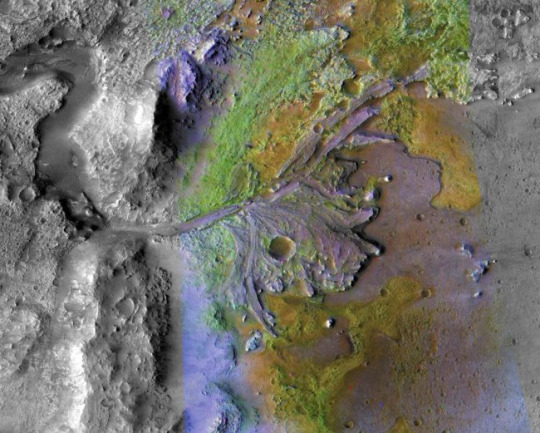
As it happens, Perseverance’s destination was one of the very last things we decided about it- not until the craft itself was fairly thoroughly engineered and designed. Formally, the decision was made by the mission directorate. In practice, they follow the consensus of the scientific community, which in turn hashes things out at a series of open-invitation workshops. Things began with a call for white papers- an open suggestion box, basically. In 2015, the first workshop narrowed things down from thirty serious proposals to eight candidates. In 2017, the second workshop further winnowed the list down to three. And in October of 2018, after three days of presentation, debate, and discussion, the final workshop selected Jezero Crater from these final three candidates using a simple vote of all attendees, and passed on the recommendation to the mission leads.
I haven’t been in the business for very long, so the final workshop was the only one of these where I actually participated. It wasn’t a close vote as such, and I didn’t break any ties, and technically we were just making a strongly worded suggestion. Nonetheless, my vote is one of the reasons why the Rover will be going to Jezero Crater instead of Syrtis Major or Gusev, and I think I’m entitled to feel ownership of this mission choice, just a little bit.
(This is, of course, terrifying.)
Having gone through the experience, there were a few surprises worth noting. The first was how small some of the numbers are here. The conference was not very large: only thirty proposals, debated by just a few hundred attendees. I’ve seen book review contests with more entries, and that are read by a wider audience. Which is to say, this is a situation that was, and is, extremely responsive to individual effort. In that small a room, populated by people that are philosophically committed to changing their minds when they see good evidence or a good argument, one person can stand up and change the future in a very real way.
The second surprise was the attendance requirements. Or rather, the lack thereof. The project is public, paid for by American taxpayers, to whom I am profoundly grateful. And one way the process reflected that public-spiritedness is that this is not a walled garden. A small attendance fee (iirc, $40?), and you’re in. You get a vote, if you want to use it. A few non-scientists even took us up on this; there’s one retiree (a former schoolteacher, I think) that’s attended every major conference I’ve been to in the last few years, and sets up a small table in the back with his home mineral collection just for fun. In practice this open-door policy is limited by the obscurity of the event itself; if you don’t move in research circles, you have to be something of a space exploration superfan to hear about it. Still, as symbols go, you could do worse.
And now that we’re coming up on the day itself, the same kind of public-facing mindset is making me think about why I was persuaded to vote for Jezero Crater, what it means to explore there, and how I’d justify that choice to those of you that made the ongoing discovery of Mars possible in the first place.
If you want to know what Perseverance is like, and what you can reasonably do with it, start with Curiosity- the two are built, more or less, on the same chassis. That means you have a mobile science lab about the size of a Volkswagon Beetle. Add some mechanical improvements (no more wheel punctures!) and a few bells and whistles (microphone! helicopter for some reason!). Trade out some of the scientific instruments- raman spectroscopy instead of a mass spectrometer, for example. And it’s got these:
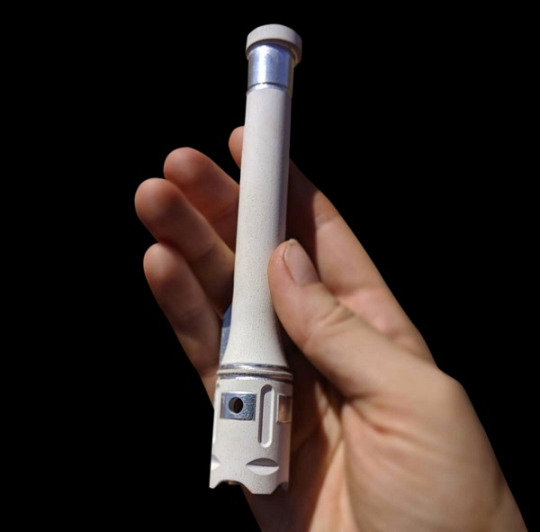
That, dear reader, is a sample return canister. Not to be returned immediately, alas, but to be returned nonetheless. One of Persevereance’s primary directives is to find interesting rocks, collect them, and leave them in place for a sample return mission in the early 30s. There’s a ton of work we can do in situ, but there’s even more we can do in a clean lab back home; things like isotopic analysis really need a much more controlled environment than you’ll get in the field. And so a major, major consideration is to optimize Perseverance’s landing site for cool rocks that we’d like to take back home.
The other thing that Perseverance is really good at is astrobiology. There’s no such thing as a life sign detector as such, but this rover represents an attempt to approach that ideal: instruments like SHERLOC and SuperCam are adept at finding organic compounds and fine-scale mineralogy and chemistry that might be influenced by microbial metabolism. This is a natural extension of what we’ve been learning so far: Spirit and Opportunity showed us that Mars formed under the influence of liquid water. Curiosity showed us that this was not just wet, but actively habitable: lakes and rivers at a neutral pH under a rich and temperate atmosphere. The next question along this line is the hardest, and the scariest: we know it was habitable, but was it inhabited?
If you’re like me, that question makes you feel weird. Collecting rocks is one thing, but a fossil? The mind rebels. We’ve spent the last two generations of space exploration tempering our expectations, reminding ourselves that the other worlds in our solar system are largely barren and dead, learning again and again how precious life is in the cosmos. It’s hard to get in the mindset of people back in the 40s and 50s who could, somewhat reasonably, imagine that Mars might not just host life but multicellular life, vegetation and robust macroscopic ecosystems. We look back at the science fiction of the era, swarthy soldiers hopping from planet to planet in silver rockets, and laugh at the naivete. A smile at the exuberance of youth, if we’re feeling generous. When we were first beginning, we may have imagined ancient canals on Mars and crystal cities on Venus, but that was when space was a blank canvas for us to paint our fantasies. We’ve learned so much since then, and if it was less fun, at least it was true. We did the hard thing and accepted reality over fantasy. We accept that extraterrestrial environments are hostile to life- cratered, silent, and still. We’re grownups now.
Unless…
Unless.
Imagine that we were born just a bit earlier. Say, three and a half billion years or so. We raise our telescopes to the sky, and we see a sister-planet. Not red, but white and blue, with an atmosphere full of clouds and multiple large bodies of water scattered across its surface, prominent ice caps and snow-capped highlands, rivers tracing their way down to the lowlands in the north. (Maybe the water is all under the ice, not open to the air at the surface; maybe the liquid pools are small and limited to craters, not feeding a large ocean.) Sober scientists might have suggested we shouldn’t get our hopes up too much- after all, the gravity is much lower, there’s no tectonic recycling, and there’s no protective magnetosphere. But is sterility really the default assumption we should be making here? Is ‘we are alone in the cosmos’ really the most sane conclusion to draw from this situation? Is it not worth, perhaps, sending a rover to go see?
We’ve adapted our sensibilities to a dead solar system because in the moment we’re looking, it kind of is. We’re hopeful for the icy moons- and the evidence keeps mounting there as well- but the terrestrial planets are a grim reminder of the fragility and contingency of our own world. The thing is, the more we learn, the more we discover that we’re a bit late to a very, very interesting party. Venus is a hellscape, but it probably didn’t start that way. Mars is a desert, but once it was an oasis. What makes Earth special among the terrestrial worlds isn’t that it developed a temperate climate, but that it kept a temperate climate for more than four billion years. Stability, not habitability, is the party trick that makes us unique in the solar system. And if we’re really committed to being grownups, to accepting what’s real instead of what’s easy, we have to learn that lesson too.
And life does not need four billion years to begin. Not even close.
That brings us to Jezero Crater. The most interesting feature here is a large river delta- based on some clever geology, we’re pretty sure that a large river emptied into the crater during Mars’ wet period. When the rapidly-flowing water hit the still water of Lake Jezero, the loose sediments being carried along the current all fell out of suspension at this place, forming a large pile of detritus at the mouth of the river that accumulated over the lifetime of the system. Even more interesting, check out this geologic map:
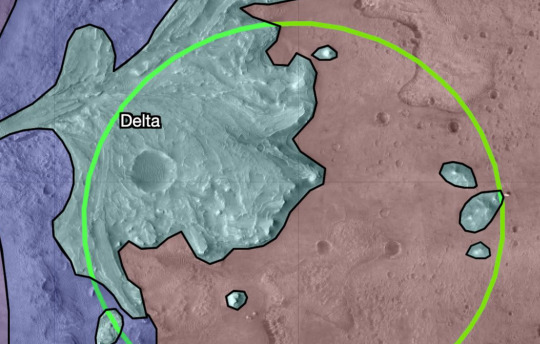
See those tiny teal deposits to the right side of the image? Those are also river delta deposits. Which means the thing labeled ‘delta’ on this map isn’t the original extent- it used to be much, much larger, at least twice as wide. Which also means that the outer edge of the ‘delta’ that we see here in this image is actually an erosional surface, and we get a natural cross-section of the thing with the oldest deposits at the bottom and the youngest at the top, just before Mars lost its hydrosphere. By climbing the outer edge, we can move through time across a large fraction of the habitable period.
Here’s another image I’d like you to see:

The crater I’ve been showing you is the small circle in the lower right- color is elevation, covering a span of about 5 km. The black line is the watershed of that river, the region of Mars that channeled water to the delta. In other words, the river delta collects sediments- and potentially, biosignatures- from a region hundreds of kilometers in diameter, and gathers them all in one place, neatly sorted by time.
For this reason, ancient deltas on Earth are a favorite of paleontologists. In addition to being comfortably wet and active itself- plenty of access to biologically important nutrients, fresh supplies of liquid water, and a nice dynamic environment- deltas do the legwork for us. Rather than exploring a huge fraction of the planet with a tiny rover, hoping that we stumble upon an ancient life sign, we can position ourselves at the mouth of the proverbial fire hose and let life come to us.
This does come with some tradeoffs. Most importantly, whatever we find, we won’t know the original geologic setting. If we find an unambiguous fossil of some kind- a microbial mat, perhaps- then we’ll know less than if we’d found it in its original home. And if we don’t find life, then the samples we take will be similarly uncertain. They’ll be defined in time, at least relative to one another, but not in space. In the case of life signs, this is an important caveat, but the bare fact of proving that extraterrestrial life exists is sufficiently monumental that it’s still a secondary concern. But if we’re just talking about geology, that’s a hard thing to lose; that terrifying multi-stage descent isn’t the only risk we’re taking. We’re leaning into the astrobiology mission hard with this one.
And the search for life is, in itself, fraught. That’s putting it mildly. There’s every chance that any evidence that’s even slightly marginal is going to touch off decades of debate, rather than being some kind of slam-dunk. As it should! Life is such a fuzzy concept, and such an important concept, that it should absolutely be held to the highest degree of scrutiny we can muster. This is why it matters that Perseverance includes sample return- in the highly likely case that the findings are disputed, we’ll hopefully have the chance to subject those samples to the highest degrees of scrutiny. So it feels like the right time to go hunting.
On top of that, there’s the ‘evidence of absence’ problem. Strong biosignatures update our priors very hard in the direction of life on Mars. But what is the correct amount of evidence necessary to convince us that Mars never was alive? I’m not sure, but failure to find microbial mats in Jezero probably isn’t enough. So the search for life can succeed, but if it ‘fails’ that doesn’t necessarily teach us much; the best experiments teach you something no matter what, and ideally a commitment this large would meet that standard. This is, more or less, baked into the search for extraterrestrial life, and there aren’t too many ways out from under that problem.
That said, Jezero in particular has some compensation. As I mentioned, we’re collecting a lot of good data regardless; and even without the gologic context, there’s a ton of opportunity to sample different minerals and how they formed, and get a nice broad sample of the Martian surface over time. And, even better, here’s the location of another interesting potential field site, in northeast Syrtis:
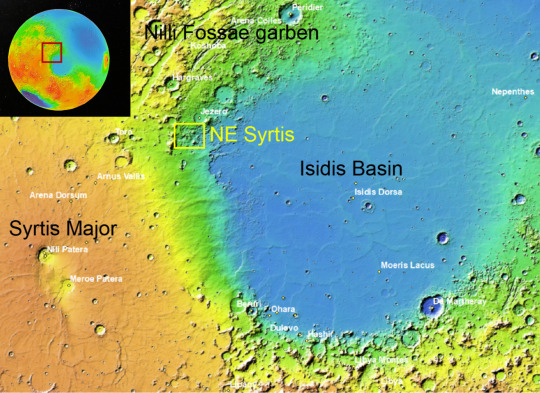
Note the proximity to Jezero crater! And Syrtis is also a fantastic candidate for a sample return mission. It has exposed mesas with layered outcrops going all the way back to the earliest days of Mars, and extending (potentially) through many of the most interesting periods. Now, these are not ideal for the search for life, although they’d give us a ton of technical data about surface chemistry and the behavior of the atmosphere during the early, wet periods; it would go a long way towards resolving arguments about the temperature of the early Martian climate, for example, or tracing the early destabilization and loss of the magnetosphere while teaching us loads about the planet’s core.
Those mesas are still pretty far away. Too far, probably, for a sensible rover lifespan to make it all the way there. But there’s a plan- called the ‘Midway’ route, as a nod to the compromise nature of it. See, halfway between Jezero and these mesas, there are a lot of banded rocks that look suspiciously like they’re sourced from the table mesas in Syrtis. And those, we can get to, maybe. If we call a specific deadline on looking for life in Jezero, then we can pivot to Midway and hopefully take a really deep look. So, in the end, we’re going hard for astrobiology research, but we’re not going all-in.
The importance of the search for life is… well, there are a lot of people out there, and we enter the world in a lot of different ways. Most of us agree that the existence of extraterrestrial life would be a Big Deal, and we tend to have a lot of different reasons for that. It’s not a bad subject for a future post or three, in fact. But there’s one thing lurking in the back of my head that’s a non-obvious reason to go looking. This wasn’t discussed at the workshop particularly, but it fed into my vote somewhat. Check the logic of this for me, see if it makes sense:
Worrying about existential risks, we sometimes talk about the ‘great filter’. That is, the mysterious phenomenon which explains the lack of extraterrestrial civilizations reaching out to us. Now, maybe we’re in a zoo or a preserve or something, and intelligences are out there watching after all; maybe the Earth really is the center of the cosmos, because of the simulation hypothesis or the various religious explanations. There’s no real way to know for sure at this point. But consider the space of very real possibilities where the universe actually is material, and actually is mostly barren. Why?
Stepping through the sequence, it might be that abiogenesis is really hard- going from a temperate world to a living one is almost (but not quite) impossible. Maybe there’s some hurdle to clear between genesis and encephalization. Maybe, given encephalization, civilization and tool-use are almost impossible. Or maybe there are many civilizations like ours, and the great filter is ahead of us- it is almost impossible for technological civilizations not to self-destruct or turn in to lotus-eaters before they reach interstellar civilization. There are a lot of possibilities for the filter, and for present purposes we’ll divide them into two categories: those which we would have already passed, and those which are in our future.
And here’s the thing: for each possibility we can exclude from the great filter, all the other possibilities increase commensurately, becoming more likely in our estimation. (Assuming the exclusion is ‘clean’ and doesn’t favor some other possibility, that is.) Given that the silence continues, if we could somehow prove that technological self-destruction isn’t a big risk, that would commensurately increase our guesses about how hard abiogenesis is.
Life on Mars, especially if we could be very sure that it evolved independently of Earth life, would be a strong argument against the difficulty of abiogenesis. One biosphere in the solar system, and nowhere else, might be down to luck. The one biosphere has to be somewhere, right? Two in the solar system, and nowhere else, is a good bit less reasonable. If we find a second genesis on Mars, then we’ve learned that life is not rare. That the hundreds of billions of stars in the Milky Way are likely host to many billions of different living (or at least once-living) worlds.
And as wonderful as that news is, as much as it makes me so happy that I literally had to take a second to cry on my bed for a bit, it also makes the great silence much, much scarier. Today, we can reassure ourselves by saying that life may be rare in the universe. But what if it isn’t? If the cosmos is full of life, but not full of thought, then…
If this is the case, we need to know. We need to know as soon as possible, and we need to know it while we’re engaged in the great project of technological development and moral progress. It’s easy to imagine that this particular mission is one that can be framed in purely positive terms- the joy of discovery, the vastness of truth, the love of how things might be. But I do also have this sense of civilizational fragility, you know? And understanding the risks that we face and the chances we’re taking- that’s not idle curiosity. That’s genuinely urgent.
212 notes
·
View notes
Text
Life in the Stone Age
Almost every day that passes sees attempts to murder Jews, because they are Jews. Some of these can even be called attempts at mass murder. No, I am not only talking about rockets launched from the Gaza strip and aimed at Israeli towns and cities. I am referring to something which almost never makes the news outside of Israel, and often goes unmentioned even here: what I have called “smalltime terrorism,” which includes firebomb and rock-throwing attacks against Jews.
If you think rock-throwing is only an annoyance, watch the video here and think about this: a rock thrown from an oncoming vehicle at one in the opposing lane strikes its target at a velocity equal to the sum of the speeds of the two vehicles, plus whatever the thrower adds to it, less a bit due to air resistance. So a rock thrown at you from a car traveling at 100 km/h (60 mph) may hit your windshield at more than 200 km/h. Let’s say the rock is 10 cm (4.1”) in diameter; it will weigh nearly 1.5 kg, or more than 3 pounds. A brick could weigh twice as much.
Such a projectile is a deadly weapon which can smash through safety glass. Even if it does not also smash your skull or crush your chest, even if it misses you entirely, it can cause you to swerve off the road, as happened to Asher Palmer and his 1-year old son Yonatan, who were murdered by Arab rock-throwers.
But what if your vehicle is a bus with 30-50 passengers? What if you are a bus driver that has to fear every oncoming car day (and especially night) in and day out? Some of the roads are narrow, with unforgiving drop-offs or rocks on either side. Last night, two buses were attacked in this way, and only sheer luck (or a miracle) prevented a tragedy. Attempted mass murder.
Throwing stones at Jews has a long history, especially in the Muslim-Arab world. Edward Said, the Palestinian-American intellectual famous for the book Orientalism, symbolically (or ineffectually) threw a stone in the direction of Israeli soldiers at the Lebanese border. It is probably the most popular form of anti-Jewish terrorism practiced by Palestinian Arabs, since it is cheap, easy, and can be practiced by terrorists of any age. Sometimes Arab terrorists build barriers in the middle of a road to force cars to stop, and then attack them with rocks before trying to drag the occupants out and beat or kill them.
The Jewish state was created so that Jews would not have to live among cultures where the of stoning Jews is an everyday occurrence. Or, for that matter, stabbing them, shooting them, or running over them with cars. But that’s what Jews face here today. And they are expected to not defend themselves. So far this month four Palestinian Arabs have been killed by Israeli soldiers or police while attempting to commit murder, or immediately after. Palestinian officials are outraged. How dare we? They are supposed to kill us, not the reverse.
The problem is the same one that the Jewish people faced after they left Egypt and found their way to the Land of Israel. It is one that has beset human tribes since there were human tribes: the need to truly possess our land and repel those that want to take it from us. The ancient and elemental nature of the struggle is demonstrated by the fact that it is partly fought with stones, the oldest of weapons.
A solution to this problem will not be found in the realm of high technology, nor in the halls of diplomacy or international law. We will not get it from the Americans along with F-35s. It will begin with the understanding that it is our land, from the river to the sea (as the Arabs are fond of saying), and that it is the mission and the responsibility of the Jewish people to populate it, and to rule it. It is our ambiguity about this mission that allows our enemies to become strong enough to think that they can prevail.
Abu Yehuda
13 notes
·
View notes